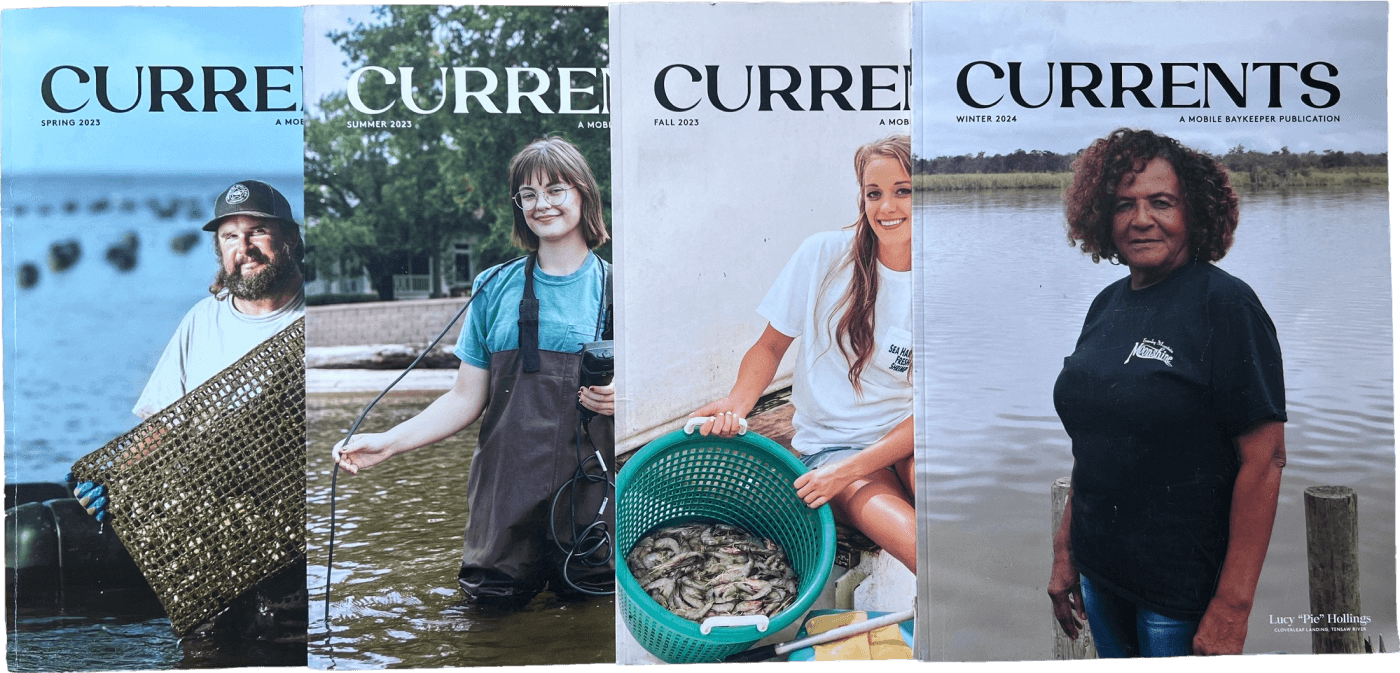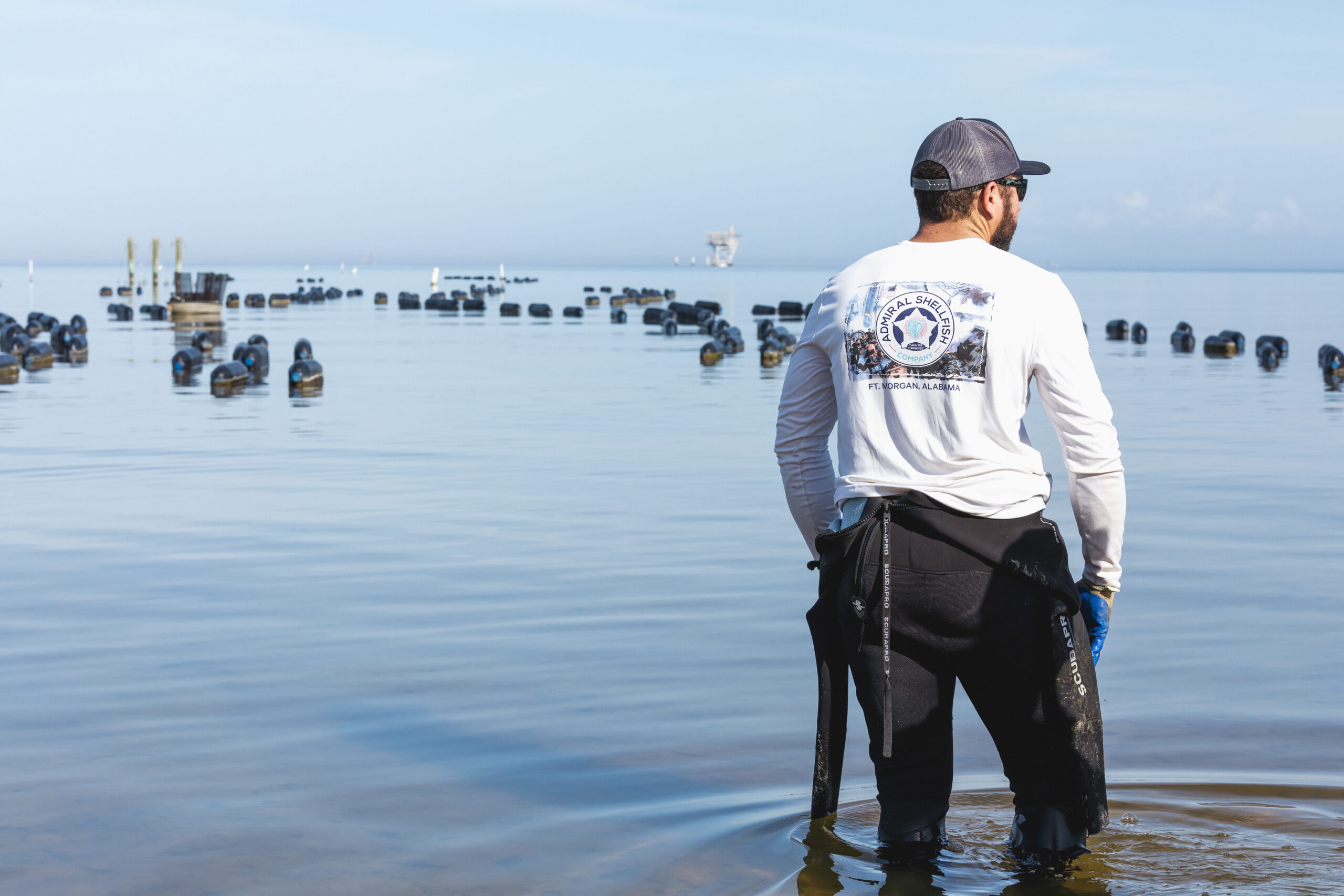
This article is from Mobile Baykeeper’s print quarterly, CURRENTS. The magazine is mailed to active members who have given more than $50 in 2023. To get on the magazine’s mailing list, donate here.
by Caine O’Rear
Photos by Alex Timoney
If you ask any first-class gourmand where to find the best oysters in the world, they will tell you to look in the claires of France or along the western coast of Ireland. Certainly in the shallow waters around Prince Edward Island in the Gulf of St. Lawrence, or in Wellfleet Harbor, Cape Cod. Somewhere in the Gulf of Mexico? Not a chance.
If they are really savvy, they will tell you about Mali Ston Bay, an oyster utopia on Croatia’s Dalmatian Coast where a variety of European flat oyster can be found that is so precious Roman emperors once funded commercial farms there, and still, two millennia later, Austrian emperor Franz Joseph was insisting that his monthly shipments to Vienna come from Mali Ston alone. In Franz Josef’s day, five hundred miles by train would be about the same as shipping overnight on a 747. In logistical terms, halfway around the world.
Such is the love for this strange and wonderful bivalve and the lengths we will go to get them — nowhere is too far to send for the best. So whether you take them by the dozen on the half-shell or fried on a po-boy, with a bottle of France’s sparkliest or with an icy schooner of what made Milwaukee famous, the humble and posh oyster inspires a love that runs deep into the heart of many cultures and culinary traditions.
The Gulf, however, has not enjoyed the same reputation for quality as these other fabled appellations. Even before the concerns brought by the BP oil spill, there was the long-held conception that the Gulf waters are too warm and turbid, and that the coastal beds where our oysters develop their unique flavor profile are not briny enough.
So what we always lacked in quality, we made up for in quantity. At least we did until BP, an event that wiped out somewhere between 4 to 8 billion oysters — a loss that has taken the mollusk three generations to replenish.
As recently as 2019, the U.S. Department of Commerce designated Alabama as one of several Gulf states whose seafood had been greatly endangered.
Hard numbers and the effects of the spill aside, such conceptions about the Gulf’s fitness for growing world-class oysters are not the whole truth. The key to growing a world-class oyster is not in a body as large as the Gulf or even as small as a single bay. And as bad as the spill was, is, the waters are healing. In beds that may be only as large as a few acres, the perfect conditions can and do exist. If only you know where to look.
(Click on photos below to access gallery.)

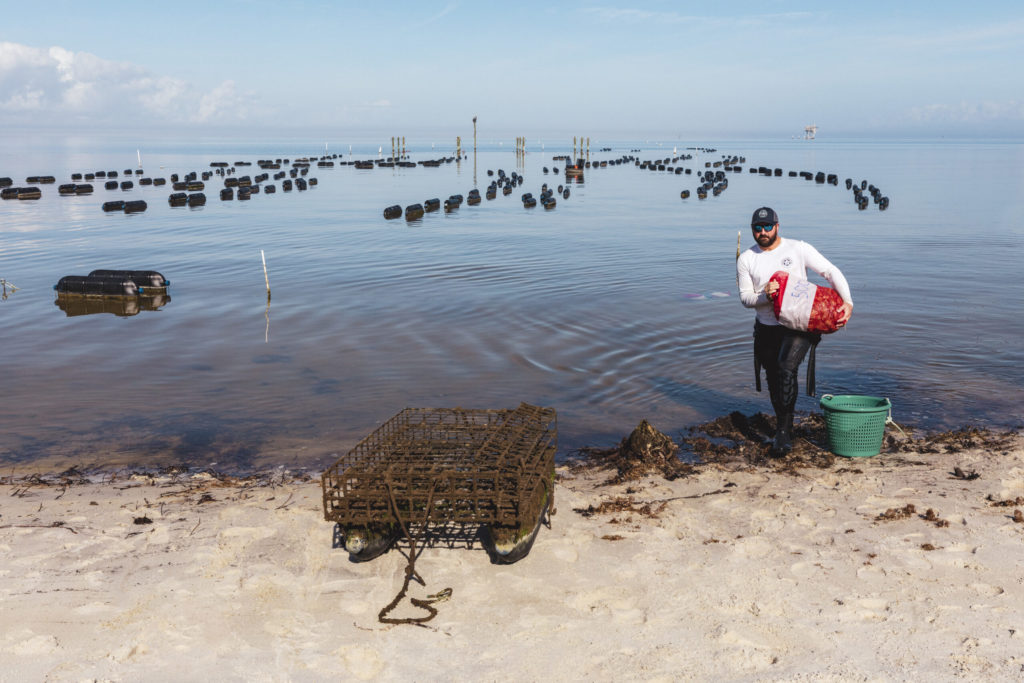

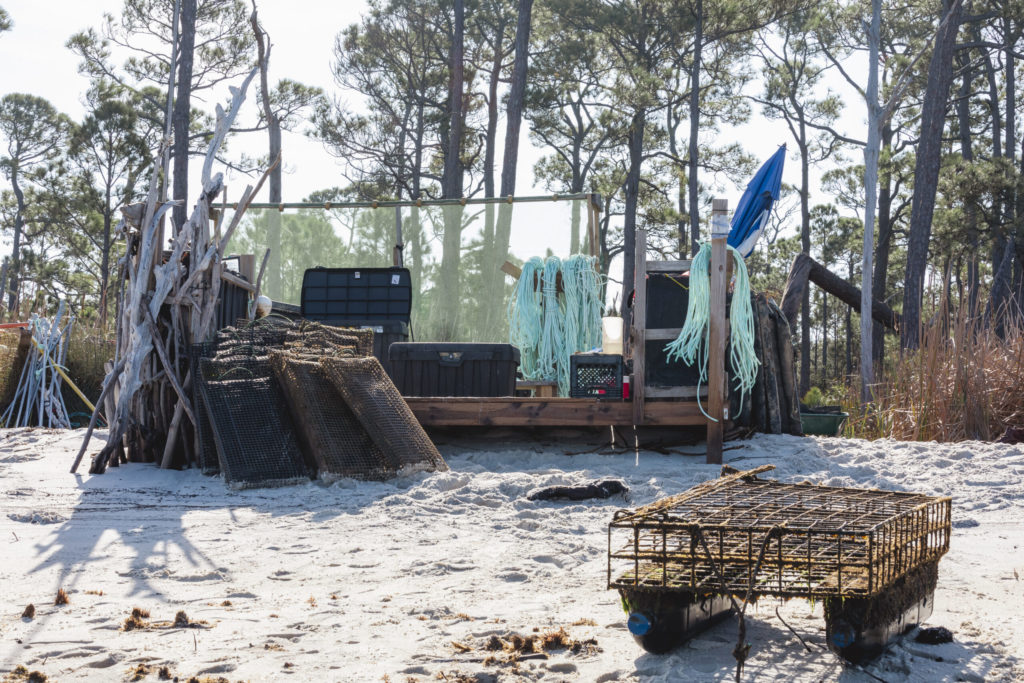
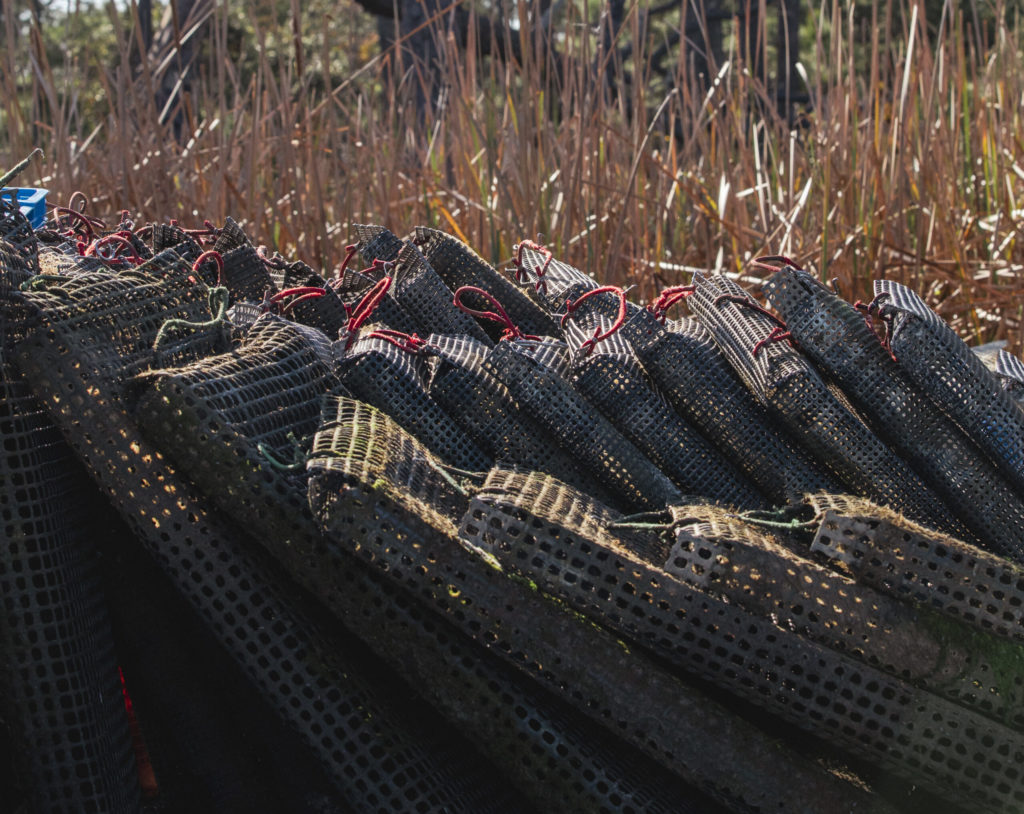
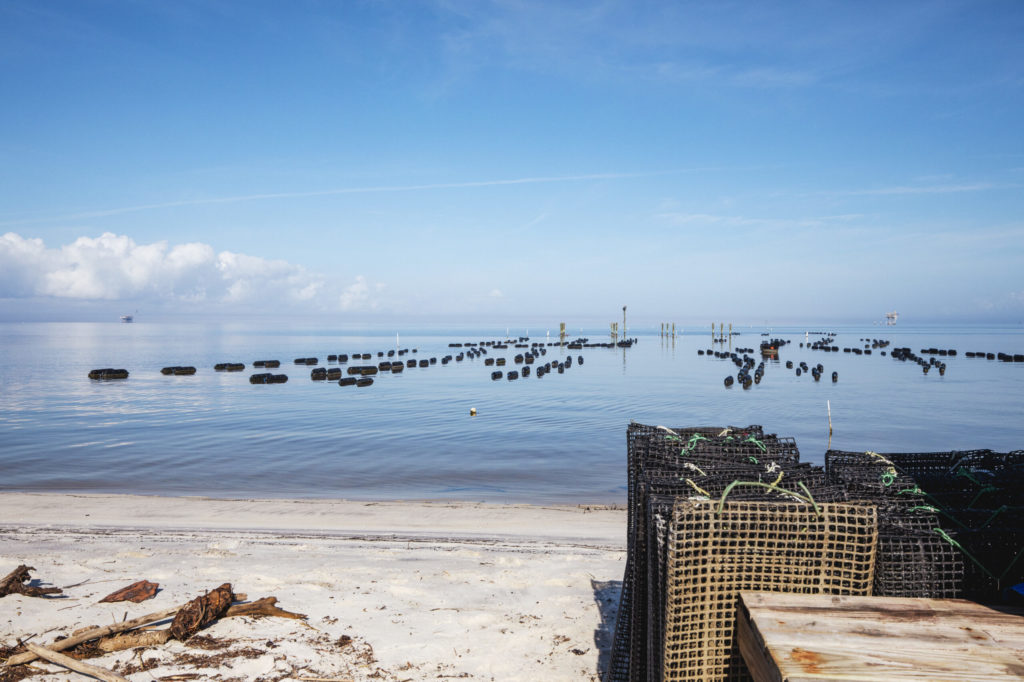
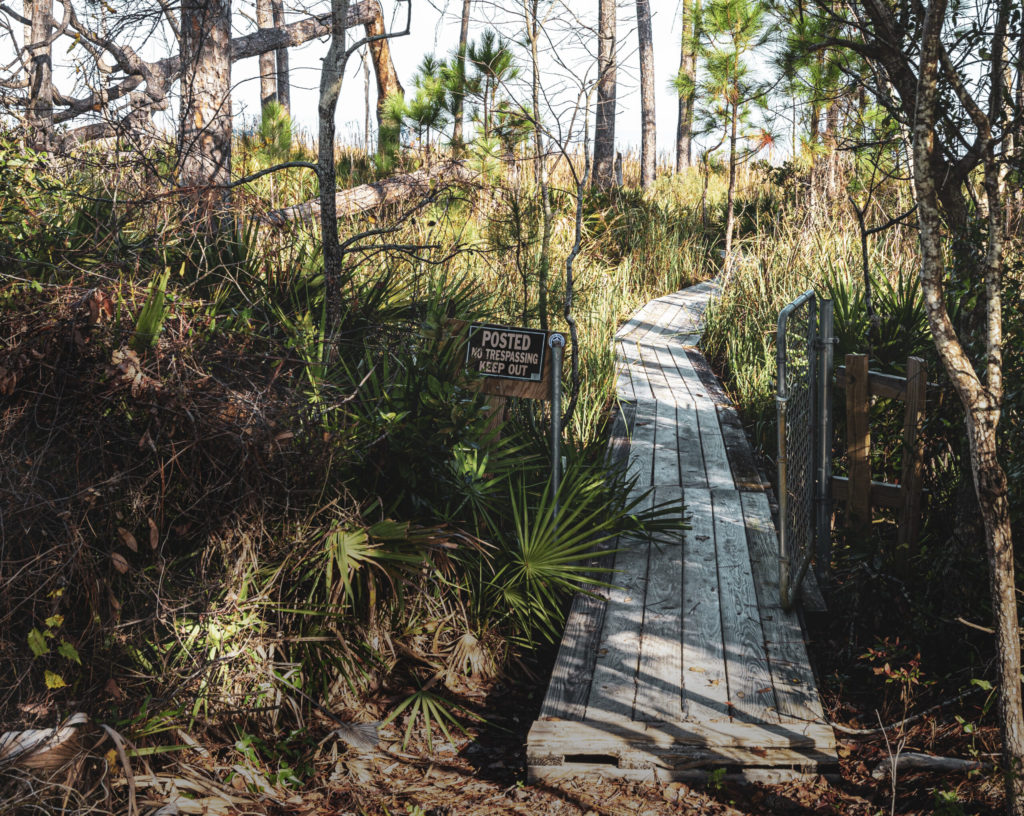
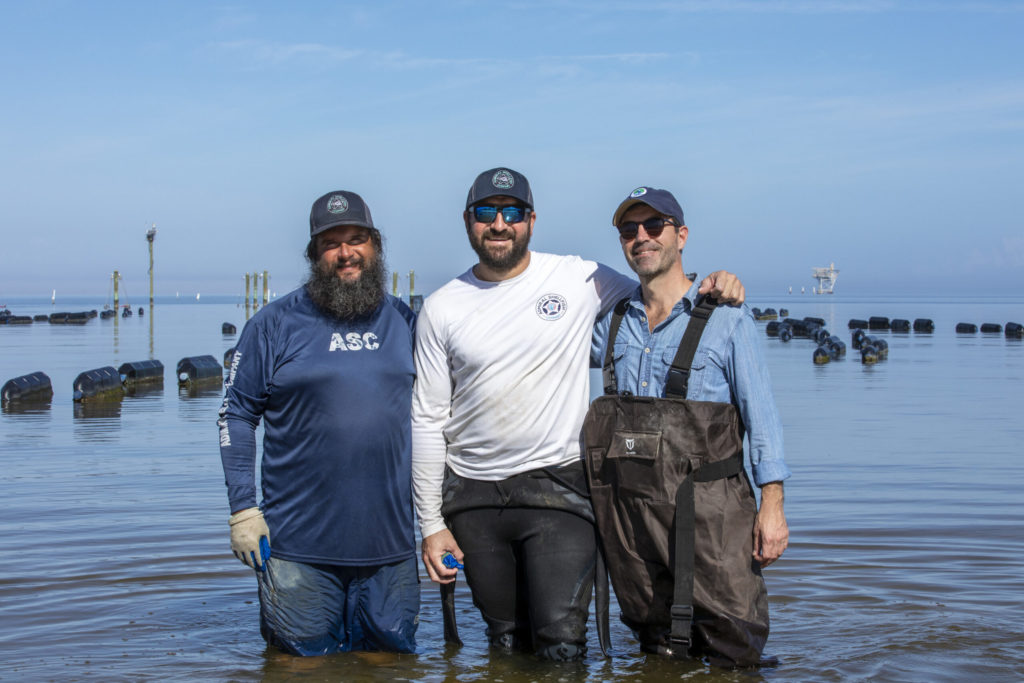

I visited the Admiral farm in early December. The morning had brought a low tide. Through the slash pines and saw palmetto at the farm’s approach, which sits just off Fort Morgan Road near the marina, you can already see it. The water is clear; so clear you feel as if you’re glimpsing the sandy bottom through a fish tank.
Nearby, about 300 yards from Fort Morgan, the remnants of the Tecumseh, the Union warship that capsized after striking a mine during the Battle of Mobile Bay, is buried beneath the Bay. The farm works with the state to ensure the site remains undisturbed. Thus the name, Admiral Shellfish Company, replete with its “damn the torpedoes” ethos.
This is Mobile Bay, I have known it my whole life, and while the water is typically less turbid during the winter months, this locale seems by contrast a different waterbody altogether from the caramel hues of the river-fed upper Bay. Here, the diurnal tide ushers in full-strength ocean water, and there is no siltation. On the hottest day of the year, the waters might reach 84 degrees, only slightly warmer than the near 80 degrees seen in Mali Ston.
As a general rule, the perpetually brackish Mobile Bay averages 10 to 20 parts per thousand (PPT) for salinity. Because of the diurnal tide, however, the coveted 20 to 24 PPT salinity level is a near constant at the farm. On the day of my visit the salinity level is at 23. Scarce rain in October and November meant the farm never went below 25 in those months.
So here, at the southern end of the Bay where the Gulf currents, underwater terrain, and surrounding geography converge in a swirl of exceptionally clear, highly saline waters, the ideal conditions exist for growing world-class oysters. In waters saturated with just the right concentration of minerals, nutrients, and phytoplankton, amid these conditions there exists some of the best that can be found, anywhere on earth.
*****
Approaching the farm’s shore you are greeted by Joe Ingraham, a bearded oysterman and great storyteller. He looks like “a pirate, 200 years too late,” as Jimmy Buffett might put it. The farm stretches out into the bay for 1,400 feet, and you can see black buoys rectangling in the sea. There are nearly 700,000 oysters growing in this space. It’s shallow and the Admiral team rarely has to use boats. It’s mostly waders when they’re out checking the cages.
Ingraham is on the farm every weekday. When you visit Admiral, and observe Joe and co-owner Anthony Ricciardone working the farm, you quickly learn this is not a project for dilettantes. Or the faint-hearted.
Ingraham is explaining the lay of the land to our photographer.
“When the cage is suspended, that’s exactly where they sit – in that top two feet,” Ingraham says. “But that also gives them protection from would-be predators.”
Ingraham and his team are constantly working with the oysters, shaking and handling and fine-tuning the bags. This is partly an effort to keep the “lip” off the shell, which is a form of curation that allows for better presentation. They also take the oysters out of the bag and let them air-dry, which helps kill off things like algae.
“In terms of a handcrafted product, we’re literally shaping the cup of the oyster. Our chefs want consistency, and they want the same branded product every day,” says Ricciardone. “With these cups, it looks like the meat is exploding out of the shell, so it makes a really cool table presentation.”
Ingraham pulls some oysters out of the water, shucks them, and shows us the contours of the cup. The point is clear.
“The fact that Admiral is concentrating that much on each cup of oyster, that is what puts their product above and beyond,” says Seth Temple, head chef at La Chat Noir, an acclaimed restaurant in New Orleans’ Warehouse District that serves Admiral oysters daily. “They’re bringing that saltier oyster that customers crave. The salinity levels are matching that of Prince Edward Island, which is extremely rare in the Gulf.”
But along Prince Edward Island, it can take three to four years to grow an oyster to market. At Admiral, they can grow an oyster to market in as little as six months, due largely to the warmth of the water, and other factors. In terms of putting Mobile Bay oysters on the global culinary map, this is an enormous advantage.
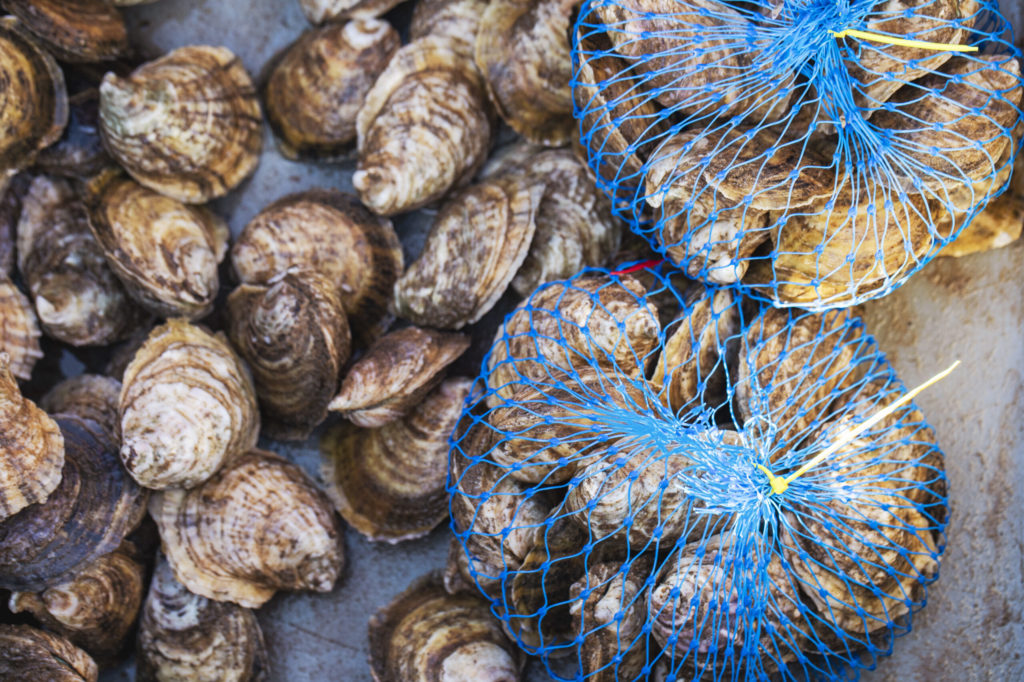
For years, the Admiral team worked diligently to find the ideal location. They are now the southernmost farming operation in the Bay, with the Mobile River nearly 40 miles from the farm. Here, the substrate of the Bay floor acts like a beach, Ricciardone notes, and there is little to no detritus present. Certain impediments to oyster farming — siltation, sulfur, low oxygen — simply do not exist here.
PJ Waters, associate professor at Auburn’s School of Fisheries and director of the Mobile Bay oyster gardening project, says Admiral’s location is the secret sauce for its product. Last year, Waters said of oyster gardening in the Mississippi Sound, which is part of the Gulf of Mexico, that there was not enough salinity present for a bountiful harvest. The mortality rate was huge, and they lost nearly all the crop. Admiral’s location is resistant to this. “That’s because where he is,” Waters says. “He’s got the sweet spot. He’s getting that salt water as it wraps around Fort Morgan, and he tends to stay salty even if the Bay goes fresh.”
Ricciardone (who co-owns Admiral Shellfish Company with environmental scientist Chris Head) was born in New Orleans and grew up in Slidell. He was raised on seafood and fishing culture. He became a pharmacist by trade, studying at Auburn University. When you spend time with him, it’s clear he’s an enterprising, driven, and talented individual. He’s a fountain of information when it comes to aqua-farming. When you see all that goes into it, you have to be. This is an extremely delicate science, not unlike winemaking. And it requires tremendous work. Make no mistake: these are not gentlemen farmers we’re talking about.
Ricciardone became interested in oyster farming after participating in Auburn’s oyster gardening program in Mobile Bay several years ago. “I started researching it as a business model and reaching out to farmers and decided to jump in,” he says. “There had been so much innovation with top-water gear, it really elevated what an oyster can be for table-fare. I saw a way to make a uniquely branded Admiral oyster. It just took years of trial and error to get it right.”
Back in 2018, Admiral Shellfish Company tried setting up shop farther up the Bay. It was then Ricciardone and the team learned about the impact of development on the river systems. When you clear an acre, and build a house on it, the chance for runoff increases greatly, Ricciardone notes. And then if there is any proximity to industry or farming, you’re going to run into some challenges as an oyster farmer. All of that freshwater runoff creates lower salinity and turbidity — not ideal conditions for table-fare oysters.
What all this amounts to is that restaurateurs from Birmingham, Atlanta, Houston, and New Orleans have taken notice even as Admiral oysters have become a big hit locally. Laurence Agnew, group executive chef at Jesse’s in Magnolia Springs, says a few factors give Admiral oysters their sterling quality. “It’s the salinity levels, and they don’t rush the process,” he says. “And I know how much they look after all the details.”
Agnew says it’s that blend of brininess along with melon undertones, especially in the spring, that makes them unique. He says he loves showing off the oysters to tourists who are trying a Gulf product for the first time. Having worked in restaurants in Ireland, Agnew says Admiral’s rival the best in the country, if not the world. Jesse’s is opening a new location soon on Fort Morgan Road (“Jesse’s On The Bay”), just a short distance from the Admiral farm. They’re even partnering with Admiral on a special boutique oyster called the “King’s Ransom.”
To achieve such a feat, that of raising a first-class proprietary variety, Ricciardone understands that clean water is necessary, and not just for oystering. He understands it’s imperative for our economy and way of life. For quite some time Admiral has sponsored a Mobile Baykeeper SWIM site at the farm’s location.
Ricciardone says it’s important for the public to know this is a safe spot to swim. He understands there aren’t a lot of places where the public can access the Bay for swimming, whether due to heavy industry on the western shore, or the wealth of private property along the eastern side. Mobile Baykeeper tests for fecal bacteria at its SWIM spots while Ricciardone notes that testing from the Alabama Department Of Health indicates there is not a problem with chloroform, red tides, or industrial pollution at the farm.
“We don’t have sewer treatment plants or heavy industry within dozens of miles from this site,” he says. “If you look at the tiny coastline of Alabama, there’s not a lot of places you can say that.” And because Mobile Bay is one big estuary, one drop of rain affects the entire system. Rainfall in Birmingham makes its presence known here days later. He understands too the threat Barry poses 40 miles upriver, and that a coal-ash spill would mean “game over” for the oyster business. “If something like Barry happens, there’s no place to hide,” he says.
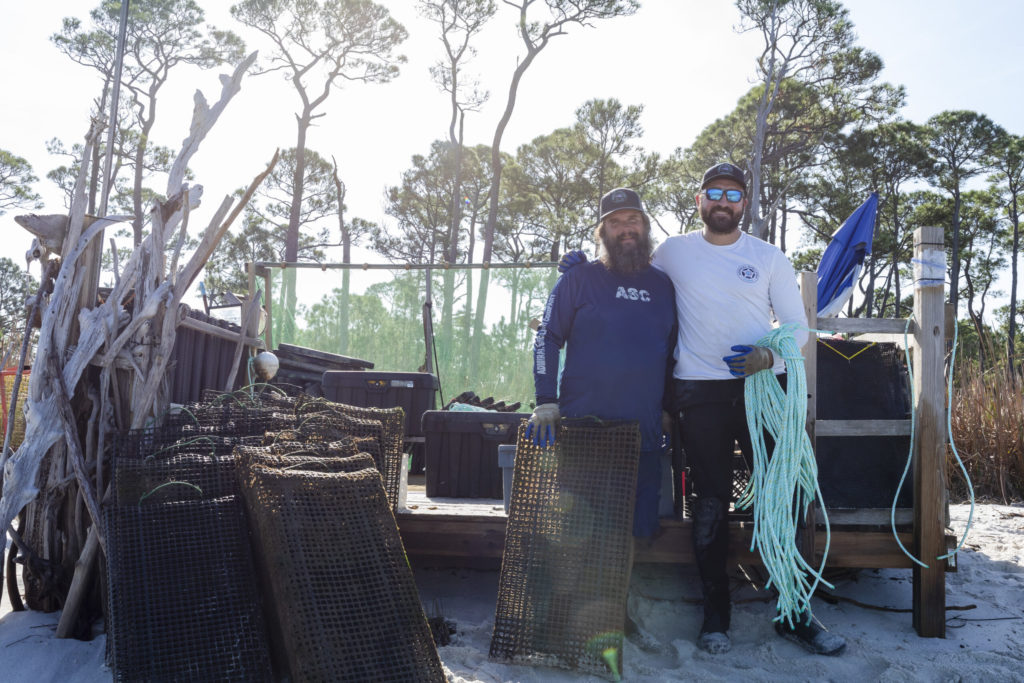
Oysters have long been known as the kidneys of the sea; they are nature’s filtration system, and a single oyster is estimated to filter fifty gallons of water per day. They don’t filter pollution, per se, but they take phytoplankton and turbidity out of the water. With three-quarters of a million oysters growing on the farm, that’s a lot of filtration.
The Alabama Department of Conservation and Natural Resources (ADCNR), through its Marine Resources Division, has been working diligently through several programs to restore the population of wild oysters in the wake of the Deepwater Horizon spill, and the work could not be more timely. Sadly, over the course of the last century, the Alabama coast has lost 80 percent of its oyster reefs.
Love them or hate them, these bivalves have been crucial to the development of cultures along the Alabama Gulf Coast, dating back to the Mississippian period (800 AD to 1600 AD). The shell middens like those found along Dauphin Island testify to their importance as a life-source.
There is, however, a difference between a farmed oyster and the wild type. The farmed variety is a curated product that offers consistency. The precision locations in which the high science of oyster farming takes place is known in the trade as merroir – a term appropriated from terroir in viticulture, or grape-growing for wine. Water chemistry, the seasons, all of these things play a role. It’s all very sensitive. And it was not something I ever considered before my visit to Admiral. For consumers, Ricciardone says the farmed-versus-wild question is like the difference between craft beer and factory beer, and it’s really about “whatever you’re into.”
Indeed, the curation process for a farmed oyster — from seed to harvest — is extreme. Not to mention that the permitting process through the Alabama State Lands Division is long and intense. The sea bed is leased from the state, and Admiral pays a yearly fee based on acreage.
Scott Bannon, director of the ADCNR’s Marine Resources Division, says the state has issued a fair number of permitted and licensed sites over the last couple of years and they’re looking to expand even more. “The product that comes out of Alabama right now is in high demand across the country,” he says. “We’re definitely encouraged by that.”
Bannon is hoping to expand the number of permitted sites for oyster farming. He notes that there are limiting factors like available real estate and access to water. But he says the state is hoping it can lease areas along the shoreline owned by Forever Wild, the state’s conservationist land trust.
Bannon understands that oyster farming is not for amateurs. This is hard damn work. But with merroir that potentially stands among the coveted few places in the world, where oysters of the highest quality can be raised, it is a challenge that some will accept.
